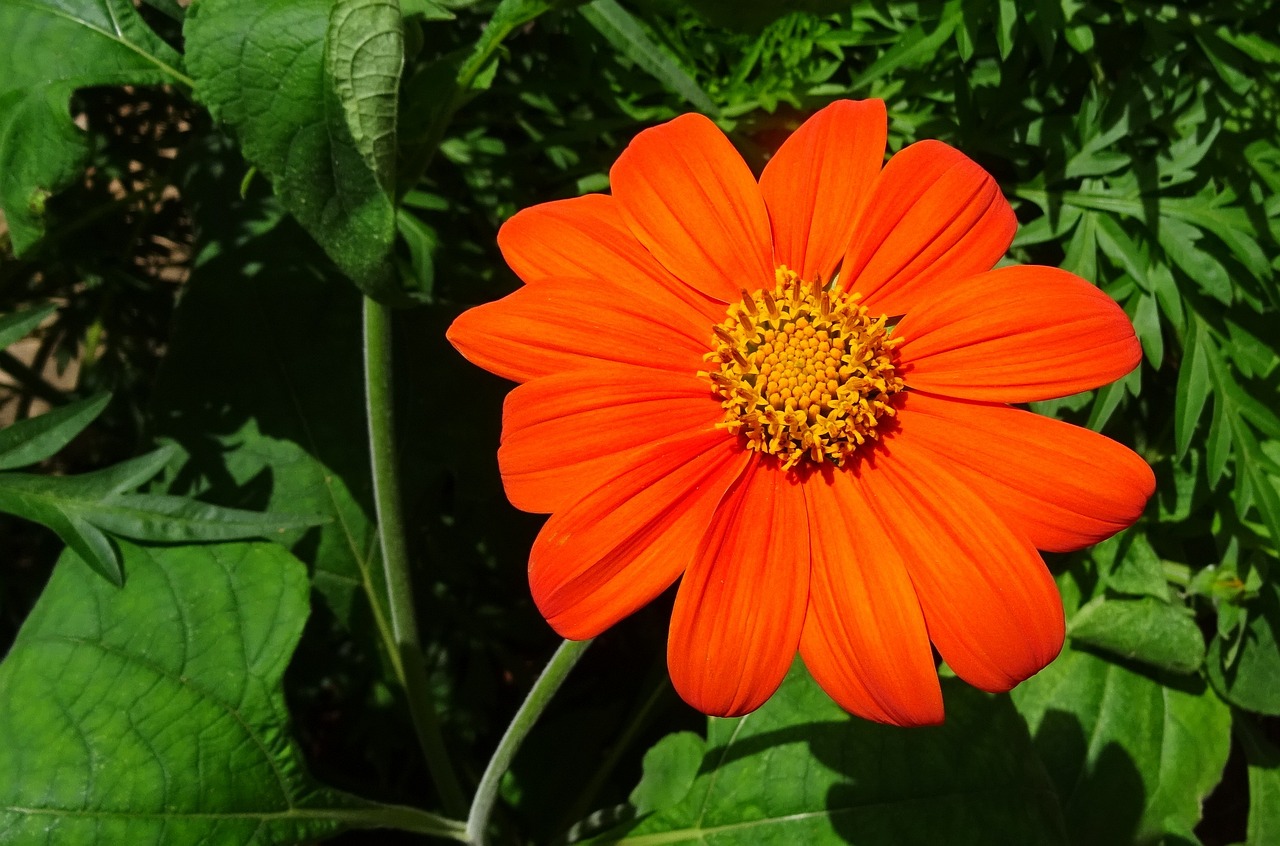 Mexican Sunflower
Mexican Sunflower
Searcy, Ark. –
As summer wears on, members of the daisy family become more important in our gardens. This happenstance is good for the butterflies because the large blooms of the daisy tribe make good perches and nectar sources for these winged delights.
One plant that really stands out in the late summer garden is Mexican sunflower, Tithonia rotundifolia.
Mexican sunflowers are large, coarse textured annuals capable of reaching 6 feet tall with a spread of half that. They produce stout, branched stems covered by broad, spade-shaped leaves growing 6 to 8 inches long. The leaves are covered with bristly fuzz, perhaps contributing to the deer-proof nature of the plant.
In the typical form, Mexican sunflower has a rangy habit that make it best suited for the back of the border. 'Torch' is the most popular of the larger selections. 'Fiesta del Sol' is a dwarf form growing about 30 inches tall that was an All-American Annual winner in 2000 and is easier to use in smaller gardens.
The bright orange flowers of Mexican sunflower are borne atop the foliage on long, hollow peduncles. The flowers are to 3 inches across with a single array of ray flowers surrounding a dense cluster of bright yellow disc florets. Blooms remain open and attractive for ten days or more, making it an effective cut flower.
The genus Tithonia was described by a French botanist in 1799 with the name taken from Greek mythology. Tithonus was a much-loved by Aurora, the dawn-goddess. The Mexican sunflower is native to Mexico.
Butterflies are general feeders that seek out any flower that will provide them with sweet, energy-rich nectar. During the hot, dry days of August large, flowered wildflowers of the sunflower tribe like true sunflowers, compass plant, cup plant and garden flowers such as Mexican sunflower are important food sources.
But just because you have a food supply for the butterfly is no guarantee you will continue to have them in your garden. Egg laying and growth of the caterpillar is quite specific. Monarchs need milkweeds as a food plant for the caterpillars; the black swallowtail requires a member of the carrot family like parsley or fennel; the pipevine swallowtail caterpillar feeds only on our native pipevine.
Mexican sunflower is an easy to grow annual. It can be seeded in place in late spring after the danger of frost is past or transplants can be found at local nurseries. It grows best in fertile, well drained sites in full sun. Deadheading during the summer keeps it in bloom through most of the season. Though not immune from insect attack, it has no serious pest problems.
Due to their height and coarse look, tithonia makes a good background plant or can be used as a living screen (just remember it’s an annual). They grow best in full sun with well-drained soils. They will tolerate poor soil, so tithonia may be a plant to try if you have an area where plants struggle. Avoid planting them in heavy soils or fertilizing them heavily (nitrogen). This can lead to tall plants that produce lots of foliage, weak stems, and few flowers.
Plants will often benefit from being staked to prevent them from falling over. Planting in a sheltered location, away from strong winds, will help prevent plants from flopping. Plants can also be pinched early in the season to produce bushier, shorter plants that are less likely to need staking. Planting plants 2-3 feet apart will also allow them to support one another.
There are a few cultivars of tithonia that can be found:
- ‘Torch’ is the “typical” tithonia and most sold cultivar. It produces red-orange ray flowers and was an All-American Selections (AAS) winner in 1951.
- ‘Yellow Torch’ has yellow ray flowers.
- ‘Fiesta del Sol’ grows to be around 3 feet tall with red-orange ray flowers—2000 AAS winner.
- ‘Goldfinger’ is also a shorter cultivar, growing 2.5-3 feet tall with yellow-orange ray flowers.
Information for article provided by Dr. Gerald Klingaman
By Sherri Sanders
County Extension Agent - Agriculture
The Cooperative Extension Service
U of A System Division of Agriculture
Media Contact: Sherri Sanders
County Extension Agent - Agriculture
U of A Division of Agriculture
Cooperative Extension Service
2400 Old Searcy Landing Road Searcy AR 72143
(501) 268-5394
ssanders@uada.edu
The Arkansas Cooperative Extension Service is an equal opportunity institution. If
you require a reasonable accommodation to participate or need materials in another
format, please contact your County Extension office (or other appropriate office)
as soon as possible. Dial 711 for Arkansas Relay.
Pursuant to 7 CFR § 15.3, the University of Arkansas System Division of Agriculture
offers all its Extension and Research programs and services (including employment)
without regard to race, color, sex, national origin, religion, age, disability, marital
or veteran status, genetic information, sexual preference, pregnancy or any other
legally protected status, and is an equal opportunity institution.